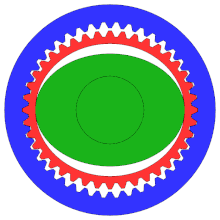Strain Wave/Harmonic Drive
- mcolabre@uwaterloo.ca
Owned by
How it works
Main parts
- Wave generator (green)
- Elliptical shaped
- Centre“hub” where the input shaft attaches, and a special bearing on the outside
- Flex spline (red)
- Cup made of flexible metal material
- External teeth on the open end of the cup
- End of the cup can change shape but the base is rigid
- Output attached to the bottom of the cup
- Circular spline (blue)
- Rigid ring with inner teeth
- Two more teeth than the flex spline
- This is what allows the flex spline to rotate
- Output ring
- Can have a fourth part depending on the harmonic drive (as explained in this video)
- located directly below the blue circular spline/stator ring. It has two teeth less than the circular spline (but the same circumference)
- The flex spline acts to “line up” the two teeth on either end of the wave generator (using the wedge force of the flex spline teeth on both the output ring and circular spline) causing the output ring to slowly turn
Functionality
- Wave generator inserted in the flex spline, causes the flex spline to assume the elliptical shape
- As the wave generator rotates, the flex spline is deformed around it
- Only the teeth at the ends of the elliptical flex spline mesh with the teeth in the circular spline
- Because of the tooth count difference, the flex spline rotates in the opposite direction by two teeth per wave generator rotation
- How does it have no backlash: the fixed shape of the elliptical generator means that there is always pressure along the major axis between the flex spline and the circular spline. This results in the flex spline being unable to wiggle, the flex spline connects to the output gear leading to no backlash
Calculating gear ratio
The gear ratio is calculated differently depending on the driving arrangement. The standard arrangement has the circular spline fixed, the wave generator as the input, and the flexspline as the output. In this case, the gear ratio is -input speedoutput speed. Other examples are shown on page 17 here. Products from Harmonic Drive®️, are displayed using this gear ratio.
Styles
Cup
- Flexspline is a cup that fits through the circular spline
- Circular spline is the largest diameter
- Wires exterior
Hat
- Flexspline is shaped like a top hat (like cup style, but with a “brim” on the output)
- Brim of the flexspline is the outermost diameter
- Hole for wires through the middle




Suppliers
Harmonic Drive ®️
https://www.harmonicdrive.net/
- One of the original companies to commercialize strain wave gearing
- This is probably the most reliable source, they also have the most variety and documentation
- Doesn’t sponsor (according to Lance) :( not surprising
Cone Drive
https://conedrive.com/strainwavegear/
Details:
- Production centres in the US
- Large variety of options
Product options:
- Offers component sets (just the plain module, would require custom housing) and gearheads (component set with housing, easier to attach to things)
- Cup, hat, or ring style
- Ring: axially compact and hollow center but has backlash
- Only offers gearheads for cup or hat
GAM
https://www.gamweb.com/gsl-robotic-strain-wave-gearbox.html
Details:
- American company
- Very positive values - maybe open to sponsorship?
Product options:
- Offers component sets and gearheads (I think)
- Cup or hat style with different options for input shafts
- Includes an “ultra thin” option
Kofon
https://www.kofon-motion.com/En/Index/productlist/name/Strain+Wave+Gear.html
Details:
- Chinese company
- Not too many options but probably enough to suit our needs
Product options:
- Component set (closed center)
- A few different gearhead styles (hollow or closed center)
Other (still to research)